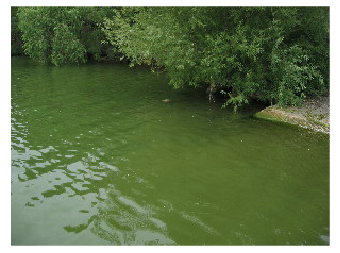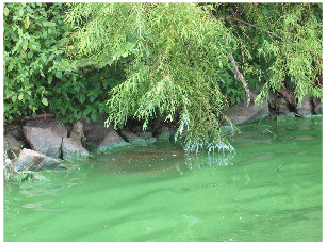Algal Blooms in Oklahoma: Lake Warnings
Oklahomans are fortunate to have access to hundreds of public lakes and ponds and thousands of miles of shorelines. These water resources provide opportunities for boating, fishing, sightseeing and swimming, which millions of Oklahoma take advantage of each year (Boyer et al. 2015). But these precious resources are under threat from merely unpleasant to hazardous pollutants such as nuisance algae, blue-green algae or unsafe bacteria like E. coli. In recent years, Oklahoma lakes have experienced an increase in blue-green algae (BGA) blooms. One of the challenges of managing for algae is that blooms may occur due to a combination of natural and man-made factors. This fact sheet provides information about BGA at lakes that may pose a risk to people and how to access the warnings issued to protect the public. In addition, a number of existing Oklahoma State University fact sheets provide information about the environmental conditions that contribute to algal problems, including BAE-1521, NREM-9206 and NREM-9210.
Background on Algal Bloom Events
Algal blooms are caused by increased growth of microscopic plants known as phytoplankton. Common types of phytoplankton include green algae and blue-green algae. Less common are brown algae, red algae and golden-yellow algae. Blue-green algae (BGA) are a special category because they are composed specifically of cyanobacteria and are not actually algae, although it was once thought that they were algae. With nutrient-rich conditions and high temperatures, these organisms can multiply to form blooms that cause the water to become a green color (Figure 1). Phosphorus loading from fertilizers used by agricultural operations and home or commercial lawns and/or lower-than-average lake levels can contribute to growth of algae as the concentration of nutrients increases. Blooms form in different levels of the lake water, the water column, and may float to the surface and accumulate near shore as green scum or mats. When the organisms in the algal bloom die and decay they can produce foul odors, deplete oxygen levels, kill fish and, on the rare occasion, produce toxins (Smolen 2007).

Figure 1. BGA dispersed in water.

Figure 2. A severe BGA bloom that should be avoided.
Very rarely are algal blooms a human health risk, but they can still be cause for concern because they affect wildlife and the appearance of water bodies. A few types of blooms can produce toxins that kill wildlife and domestic animals. Golden algae can produce blooms toxic to aquatic life, such as fish and mussels. While golden algae are not harmful to humans, pets or livestock, people should not pick up dead fish for consumption. More often, decaying algal bloom scums are a problem to visitors and shoreline residents because they make the beach look bad and produce smelly odors.
While light to moderate BGA blooms are a normal and usually harmless part of lakes, heavy BGA blooms can be a danger to people. BGA can produce toxins that make water unsafe to drink (although humans should never drink untreated lake water) and cause sickness in humans and animals. Possible health effects can depend upon how much contact with the algae the person had and his or her age. Contact with high concentrations of BGA increases the chance of rashes, stomach or liver sickness, lung and neurological effects. Symptoms can take anytime between a few minutes to several days to appear. Unfortunately, there currently are no tests to detect BGA toxins in people. People, and particularly children, are advised to avoid areas where there is a green film on the surface of the water or up on the bank. Pets and livestock should be kept away from swimming, wading or drinking in water bodies where BGA is suspected or reported. However, specific reports of any individual harmed from an algal bloom in Oklahoma have not been made to date, so the risk of harm is very low.
Current Algal Bloom Conditions in Oklahoma
Certain lakes appear more susceptible to algal blooms, but hot temperatures and low water levels can increase the chance of events. Expect more blooms to occur during drought conditions. Information on the conditions for BGA at lakes in Oklahoma can be found on the TravelOK website at www.travelok.com/checkmyoklake/ (Figure 3). You can access this website easily by typing in “checkmyoklake.com” into the web address bar. Then search for the lake you would like to check by clicking and scrolling through the list next to the text “Check Current Conditions.” For popular lakes, like Grand Lake and Lake Texoma, this website provides regular updates about water temperature, water levels and fishing conditions, in addition to water quality, so it is worth checking out regularly.
Figure 3. The travelok.com website has page with information on current BGA conditions at Oklahoma lakes.
Bibliography
Beem, M. 2011. Common Pond Problems. Oklahoma Cooperative Extension Service Fact Sheet, NREM-9206. Oklahoma State University.
Beem, M. 2011. Neighborhood and Urban Pond Management. Oklahoma Cooperative Extension Service Fact Sheet, NREM-9210. Oklahoma State University.
Boyer, Tracy A., L.D. Sanders, R.T. Melstrom, A. Stoecker and S. Ferrell. 2015. Water-based Recreation in Oklahoma: Water Rights, Valuation, and Implications for Public Policy, Economic Development, and Management. Oklahoma Cooperative Extension Service Fact Sheet, AGEC- 1057. Oklahoma State University.
Smolen, M.D. 2007. Phosphorus and Water Quality. Oklahoma Cooperative Extension Service Fact Sheet, BAE-1521.
Associate Professor
Brannon Daniels
Graduate Student
Assistant Professor & Extension Economist

